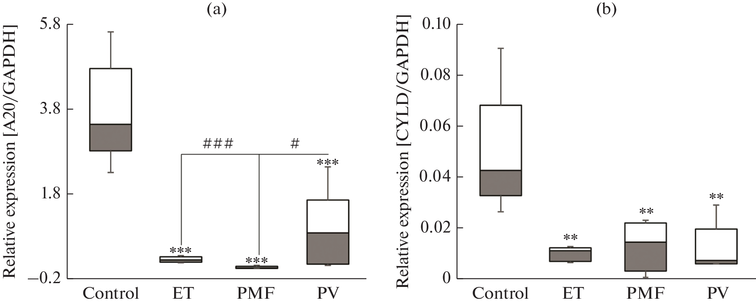
Polymorphisms and Expression of Genes Associated with JAK/STAT Signaling in Patients with Myeloproliferative Neoplasm - Cytology and Genetics
Abstract Myeloproliferative neoplasms, encompassing essential thrombocythemia, primary myelofibrosis, and polycythemia vera, represent a subset of hematological disorders within the Philadelphia-negative subgroup. The molecular network involved in the JAK/STATs signaling pathway has been demonstrated involved in the genetic landscape of Myeloproliferative disorders in several studies. Deubiquitinating genes such as CYLD and A20 are known as negative regulators of immune reactions. In this study, we assessed the expression levels of CYLD, A20, SHPs, and STATs genes by q-PCR. Additionally, genotyping via Kompetitive Allele Specific PCR (KASP) was employed to discern the genotypes of 5 variants within the A20, JAK2, HLA, and OR10Q2P genes. Furthermore, levels of inflammatory cytokines and cancer antigen 125 (CA-125) were quantified using enzyme-linked immunosorbent assay (ELISA). Results showed that mRNA levels of CYLD, A20 and SHP-1 were significantly lower in all Myeloproliferative neoplasms patients, while expressions of SHP-2, STAT1 and STAT6 were significantly enhanced in Essential thrombocythemia patients when compared to controls. Concentrations of inflammatory cytokines IL-6, TNF-α, IL-1β as well as the cancer antigen protein CA-125 were elevated in Myeloproliferative neoplasms cases. Genotyping results explored that rs10974947 in JAK2, rs200878487 in A20, and rs2281389 in HLA had higher frequencies in PMF cases compared to controls. Importantly, two novel associations as our knowledge, between the variant HLA rs2281389 (p = 0.004, OR = 2.6, 95% CI = 1.36–4.85) and OR10Q2P rs12289961 – a LPXN-nearby variant (OR = 1.95, 95%CI = 1.01–3.75) with Polycythemia vera were detected in this studied population. These data suggested that A20, JAK2, HLA and LPXN genes may have important functions in disease phenotypes. Nevertheless, further functional studies on these genes should be carried out for a better understanding of Myeloproliferative neoplasms pathogenesis.